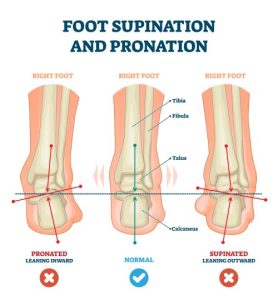On paper, running can seem like a pretty straightforward physical activity. It does not require any specific form or excessive investment in the form of a gym membership or getting some machinery.
All you need is a pair of running shoes, and you are set to go on a run. So, why are there so many research articles and lengthy books that are based on running?
Running may seem simple, but after going into the complexities, you will realize that it is much more than a simple physical activity. There are a number of different variables that you need to take into account when going out on the run.
A common aspect of performing any sort of exercise is that you must take care of the equipment that is primarily involved when performing the exercise. This is applicable in this case as well. The equipment, in this case, is your feet, as they are primarily used when running. So proper care is important.
Let us discuss what pronation is. We’ll look at the role it plays in the proper maintenance of your feet while you are running. We’ll also explore the different types of pronation that exist.
What is Pronation?
This term refers to the inward roll that can occur in your footing sometimes while you are out on your run. It is most commonly known to occur on the outer edge region of your heel as it makes contact with the ground with each stride that you take.
Pronation is an important aspect of running, and your foot requires this in order to run correctly. However, it is possible to damage and injure your foot as a result of overpronation.
As the name suggests, excessive pronation while out on your run can be the leading cause of overpronation. It is common for your foot arch to completely flatten out when this occurs.
Furthermore, overpronation also causes your muscles, tendons, and ligaments that exist throughout the underside of your foot to become stretched more than necessary.
Although there are many shoes that are designed keeping pronation in mind, overpronation can still be something that is likely to occur.
Different Types of Pronation
Although this may seem obvious, there are several types of pronation that you can incorporate when you are out on your run.
These different types of pronation are mainly dependent on factors such as the stride that you take when you are running. This is because taking different strides will result in your foot arching in different ways when it contacts the ground, resulting in a different sort of pronation.
Let’s discuss this in a bit more detail, talking about the different types of pronation that exist and how they can help you in different ways.
· Neutral Pronation
This type of pronation is said to occur when your foot is said to roll in an inward position when it hits the ground. There is no set angle, but many professional runners and trainers say that the sweet spot is around 15% roll. This allows you to absorb the shock when your foot hits the pavement.
sweet spot is around 15% roll. This allows you to absorb the shock when your foot hits the pavement.
Shock absorption is integral to maintaining proper form and stabilization when running. It helps your ankles and legs to be properly aligned.
Another added benefit of adopting this sort of pronation when running is that it also makes you less prone to some common running injuries that can occur when practicing the other types of pronation.
· Supination
Before understanding the functionality of this type of pronation and how it is capable of affecting you, it is first important to understand what exactly this means.
Supination, also known as under pronation, is the direct opposite of pronation. It occurs when your foot rolls outward rather than inward when it comes into contact with the ground.
Under pronation is something that can be used as a tool to propel yourself forward at a faster rate than normal. This is because when your foot rolls outward during the push-off phase, it helps your heels lift from the ground. This results in a fast propelling motion.
However, practicing this technique excessively can cause damage to your foot. How it works is that, due to the nature of this type of pronation, when the foot rolls outward, it places added pressure on your outer toes.
This added pressure on your toes can result in developing negative conditions such as suffering from ankle sprains, Achilles tendonitis, or shin splits as well.
· Over-Pronation
Just like under pronation, this also depends on how your foot rolls when it hits the ground. Overpronation is something that occurs when your foot rolls more than the preferred 15%.
What makes this different from the other pronation types is that, unlike the other ones, the direction in which your foot rolls does not matter.
This means that, whether your foot rolls inwards or outwards, if it exceeds the 15% threshold for rolling while this occurs, it can result in a case of overpronation.
People who are suffering from this medical condition are said to have ‘flat feet’. There are many other adverse effects that can occur due to over-pronation, such as developing iliotibial band syndrome, which is said to cause pain in the outward region of your knee.
Wrap-up
To sum everything up, pronation is something that is said to occur when your foot rolls inwards when it makes contact with the ground.
Practicing this technique while out on your run can result in positive development when it comes to pacing and speed. It can also result in the development of negative conditions such as ankle sprains as well.
However, there are many pieces of equipment that you can wear such as orthotic inserts. They can greatly help you prevent the possibility of having any of the negative conditions associated with under or over-pronation.
[wpchatai]


